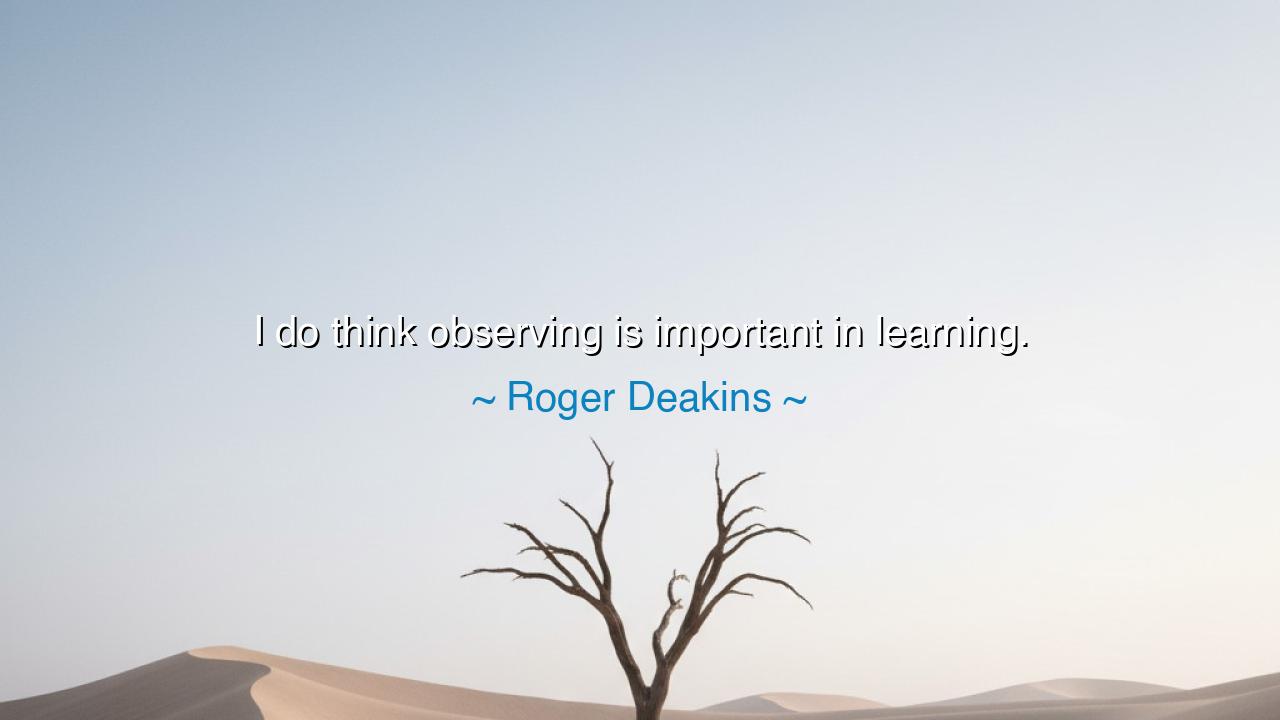
I do think observing is important in learning.






“I do think observing is important in learning.” — Roger Deakins
In this quiet yet profound statement, Roger Deakins, the master of cinematic light and shadow, speaks not only as an artist but as a philosopher of perception. His words remind us that learning does not begin in action, but in awareness — in the stillness of the gaze, in the patience of the mind that watches before it moves. To observe, in its truest sense, is to open oneself to the world with humility, to see without rushing to judge, to listen without needing to speak. For only through observation do we begin to understand the patterns that shape both nature and the human soul.
The ancients revered this wisdom. The great philosophers and craftsmen of old — from Aristotle, who studied the flight of birds to comprehend the laws of motion, to the monks of the East who meditated upon the flicker of a single flame — all understood that learning is born first from seeing. Before one can act with wisdom, one must look deeply. The hunter studies the wind before drawing his bow; the sculptor watches how light caresses the marble before striking it with his chisel. In this way, observation becomes not a passive act, but an art — a discipline that connects the outer world to the inner spirit.
For Deakins, whose craft lies in capturing the essence of a scene through the lens, observation is the foundation of storytelling. A cinematographer who has framed the vast deserts of 1917 and the neon-lit depths of Blade Runner 2049 knows that the power of the image lies not in invention alone, but in seeing the truth of light, motion, and human emotion. His mastery did not come from hurrying to create, but from years of watching — studying the way sunlight falls through dust, how shadows breathe across faces, how silence can speak louder than dialogue. In learning to observe, he learned to reveal the soul of reality itself.
History, too, is rich with those who learned through observation. Consider Leonardo da Vinci, who filled his notebooks with sketches of clouds, muscles, birds, and machines. He was not content merely to imagine — he watched the world as though it were a sacred manuscript written by the hand of nature. From the way water rippled in a stream, he learned the secrets of motion; from the study of anatomy, he discovered how the divine is hidden within the human form. Leonardo’s genius was not a gift of birth alone; it was the fruit of seeing deeply and faithfully recording what others overlooked.
But observation is not limited to the artist or the scientist — it is the foundation of wisdom in every field of life. The wise teacher observes their students to understand how best to guide them; the healer observes the patient’s words, tone, and silence alike; even the parent learns from observing their child’s curiosity and pain. To observe well is to see the world not merely with the eyes, but with the heart. It is to notice the subtle rhythms of change, the quiet lessons hidden in failure, the beauty in the ordinary. Through such seeing, we become learners of life itself.
Yet, the art of observation requires patience — a virtue easily lost in an age of haste. The modern world, drowned in noise and distraction, tempts us to act without seeing, to speak without listening, to know without understanding. But as Deakins suggests, learning without observing is like trying to paint with one’s eyes closed. To truly grow, we must reclaim the sacred act of looking. We must slow down and let the world reveal itself to us, for wisdom cannot be grasped by force — it must be received through stillness and attention.
The lesson, then, is clear and timeless: see before you act, observe before you decide, learn before you speak. Let every sunrise, every human face, every moment of silence become your teacher. If you are an artist, watch the play of light; if you are a leader, observe the hearts of those who follow you; if you are a seeker, observe yourself. For in every act of true observation, the universe unveils another layer of meaning. This is the way of all who wish to grow — to look, to listen, and to learn endlessly. As Roger Deakins, the poet of light, teaches us: when we learn to truly see, the world itself becomes our greatest classroom.






AAdministratorAdministrator
Welcome, honored guests. Please leave a comment, we will respond soon